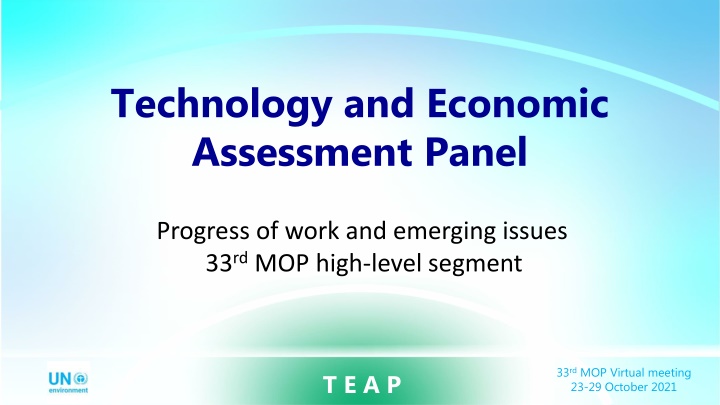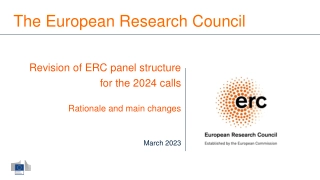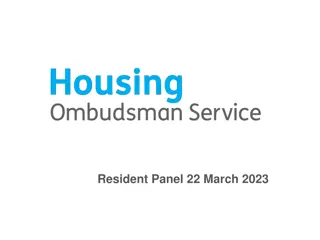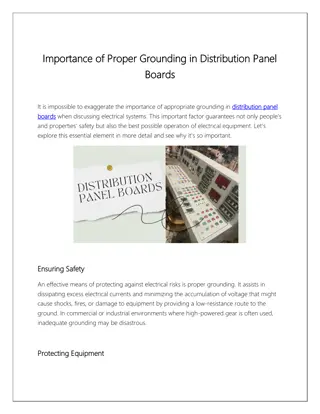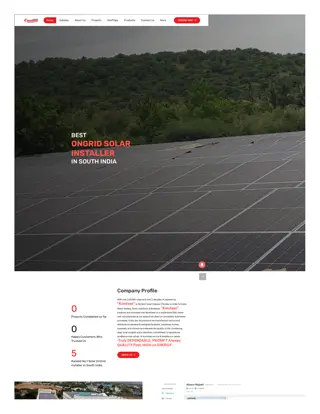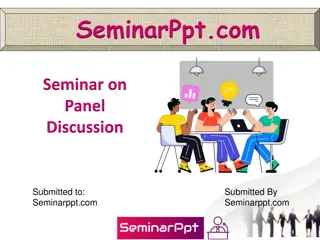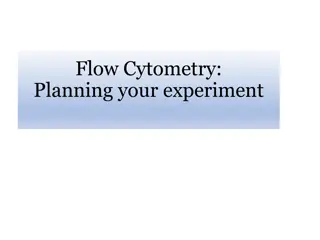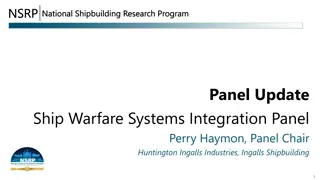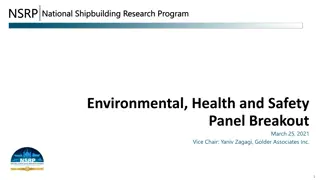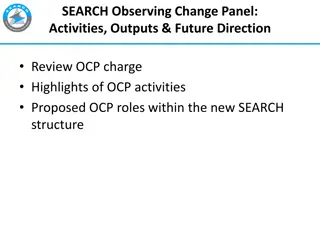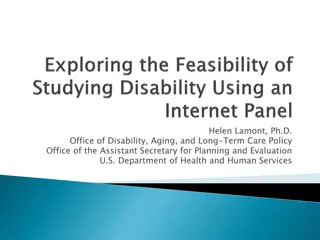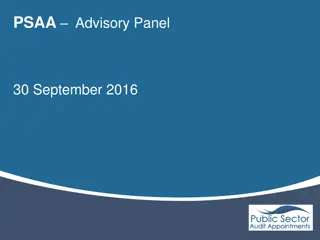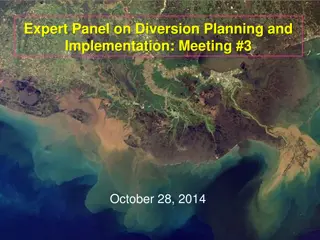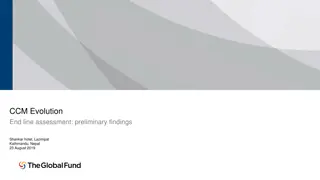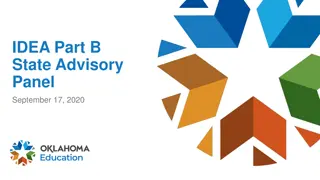Technology and Economic Assessment Panel Progress and Challenges
The Technology and Economic Assessment Panel (TEAP) has been actively contributing to the Montreal Protocol, facing challenges due to the COVID-19 pandemic. Despite adapting processes virtually, TEAP's expert members have provided multiple reports and are planning future discussions for maintaining technical expertise and serving parties effectively.
Download Presentation

Please find below an Image/Link to download the presentation.
The content on the website is provided AS IS for your information and personal use only. It may not be sold, licensed, or shared on other websites without obtaining consent from the author.If you encounter any issues during the download, it is possible that the publisher has removed the file from their server.
You are allowed to download the files provided on this website for personal or commercial use, subject to the condition that they are used lawfully. All files are the property of their respective owners.
The content on the website is provided AS IS for your information and personal use only. It may not be sold, licensed, or shared on other websites without obtaining consent from the author.
E N D
Presentation Transcript
Technology and Economic Assessment Panel Progress of work and emerging issues 33rd MOP high-level segment 33rd MOP Virtual meeting 23-29 October 2021 T E A P
TEAP Membership 2021 Bella Maranion, TEAP Co-chair USA Kei-ichi Ohnishi, MCTOC Co-chair JP Marta Pizano, TEAP/MBTOC Co-chair COL Roberto Peixoto, RTOC Co-chair BRA Ashley Woodcock, TEAP Co-chair UK Fabio Polonara, RTOC Co-chair IT Omar Abdelaziz, RTOC Co-chair EGY Ian Porter, MBTOC Co-chair AUS Paulo Alto , FTOC Co-chair BRA Rajendra Shende, Senior Expert IN Suely Carvalho, Senior Expert BRA Helen Tope, MCTOC Co-chair AUS Adam Chattaway, HTOC Co-chair UK Dan Verdonik, HTOC Co-chair USA Ray Gluckman, Senior Expert UK Helen Walter-Terrinoni, FTOC Co-chair USA Marco Gonzalez, Senior Expert CR Shiqiu Zhang, Senior Expert PRC Sergey Kopylov, HTOC Co-chair RF Jianjun Zhang, MCTOC Co-chair PRC T E A P 2
TEAP 2021 Reports TEAP Progress Report (Sept 2021) Progress Report Addendum - RTOC Vaccines Cold Chain Technical Note (Sept 2021) Evaluation of 2021 CUNs for methyl bromide and related issues - Interim report (reposted June 2021) Evaluation of 2021 CUNs - Final report (Sept 2021) Decision XXXI/3 Task Force Report on Unexpected Emissions of CFC-11 (May 2021) Decision XXXI/7 EETF Report: Continued provision of information on energy- efficient and low-global-warming-potential technologies (May 2021) Decision XXXI/1 Replenishment Task Force Update Report (Sept 2021) T E A P 3
TEAP Challenges The COVID pandemic has required Montreal Protocol processes to adapt (e.g., online comment forums, written responses to comments, extended technical sessions, repeated presentations, expanding scope over time). Despite the substantial additional workload and challenges with maintaining consensus and engagement virtually, TEAP has provided 14 reports since MOP-31. TEAP and TOC memberships are world-leading technical experts in their field, and we constantly strive to maintain that level of independent technical and economic expertise for the service of parties. TEAP is aware of the need to ensure that its membership meets the evolving needs of parties whilst ensuring continuity of its work under the Montreal Protocol. TEAP is planning face-to-face discussions in 2022 on its structure, membership and future directions to present in its 2022 Progress Report. T E A P 4
TOCs Updates: Sector Highlights & Emerging Issues 33rd MOP Virtual meeting 23-29 October 2021 T E A P
Flexible and Rigid Foams TOC There is continued progress in the adoption of zero ODP and low GWP foam blowing agents; however, there are ongoing issues especially for small- and medium-sized enterprises. The cost of HFCs and HFOs/HCFOs The safe use of flammable blowing agents Supply chain issues have emerged in A5 and nonA5 parties related to: Sufficient capacity for low-GWP options Access to raw materials Weather-related disruptions to chemical plants for both low-GWP blowing agents, and also polyols Shipping disruptions T E A P 6
Halons TOC New fire suppressants take many years in R&D. Installation in civil aviation takes even longer. Recovered halons are now reported to be increasingly contaminated and require additional effort to recycle with potentially additional losses. Recycling companies have reported problems shipping halons across international borders including misapplication of the Basel Convention. Ship breaking could represent a significant source of halon 1301 - amount available under investigation There is a need for awareness programs to reverse the apparent loss of institutional knowledge on requirements for halon management. T E A P 7
Halons TOC - 2 Emissions derived from atmospheric measurements appear to plateau, contrary to the expected decrease in emissions consistent with a decreasing bank decreasing flight hours in civil aviation resulting from the pandemic Presented at ICAO Air Transport Bureau, 29 June 2021 T E A P 8
Methyl Bromide TOC There is good progress with critical use nominations (CUNs) for methyl bromide (MB) now down to less than 70 tonnes/year. Article 7 data suggests some parties may not be distinguishing controlled versus uncontrolled use appropriately Stocks: Parties may wish to consider reporting rules. Parties with CUNs mandated to report stocks (20 tonnes) Parties without CUNs do not report stocks but may hold an estimated 1500 tonnes Quarantine and Pre-shipment (QPS) stocks could be being used for controlled uses Parties may wish to consider Quarantine versus Pre-shipment separately. QPS (10,000 tonnes) - now >150 times more MB compared to CUNs. PS - alternatives exist - lower standard of pest control required Where MB still essential, consider improved recapture/recycle technologies T E A P 9
Medical and Chemicals TOC Atmospheric-derived emissions for a range of controlled substances are higher than expected based on reported production (e.g., CFC-113/113a, HCFC-132b, -133a, -31). Clearer understanding of production of feedstock, intermediates, by-products, would allow meaningful analysis of global and regional emissions. Global HFC-23 emissions were at their highest in 2018 compared with emissions expected as the by-product of HCFC-22 production. Planned HFC-23 emissions reductions may not have been fully realized, or there may be unreported HCFC-22 production. An assessment of technologies used for the destruction of controlled substances under decision XXX/6 will be included in MCTOC s 2022 Assessment Report. MCTOC will also provide an update on related issues surrounding the destruction of banks of controlled substances. T E A P 10
Refrigeration, Air Conditioning and Heat Pumps TOC Since RTOC 2018 Assessment Report, 1 single-component refrigerant and 14 blends have achieved classifications as per ASHRAE-34 and ISO-817. To allow the use of low GWP flammable refrigerants, international institutions are working to review the refrigerant charge in different applications, with appropriate safety standards. IEC 60335-2-89 (commercial refrigeration) was revised to include larger charges of flammable refrigerants (up to 500 g 1200 g) and is currently being transferred to national standards. Work on IEC 60335-2-40 (air conditioning and heat pumps) is on-going, aimed at increasing the charge per unit room floor area for all flammable refrigerants. Training in the servicing and maintenance of RACHP equipment to reduce leaks will reduce emissions of high GWP HFCs. Vaccine Cold Chain Technical Note (Report on the OS website). T E A P 11
TEAP Task Forces 33rd MOP Virtual meeting 23-29 October 2021 T E A P
Decision XXXI/1 Assessment of the Funding Requirement for the Replenishment of the MLF for the period 2021-2023 To support negotiations on replenishment of the Multilateral Fund (MLF) and as instructed by parties, the TEAP Replenishment Task Force (RTF) updated its 2020 report. The RTF September 2021 Report estimated funding requirement for the 2021-2023 triennium has been narrowed to US$ 417.5-779.6 million, which reflects: Updated HFC phasedown funding scenarios that are based on Kigali Amendment ratifications as of 17 June 2021, with 84 A5 parties having ratified (including the largest country in Group 1) and 142 A5 parties that sent letters of intent to ratify. Planned and approved projects in the Adjusted Consolidated Business Plan for the MLF for 2021-2023 allowed use of actual amounts rather than estimates (e.g., HPMPs) for this triennium. New project preparation cost guidelines agreed by ExCom for Kigali Implementation Plans (KIPs) were taken into account. HFC production sector and HFC-23 mitigation projects agreed or approved in principle at ExCom were also taken into account. As requested in the decision, RTF estimates include support for the special needs of low- and very low- volume consuming countries, enabling activities, stand-alone projects, and cost of early activities to avoid the growth of high-GWP HFCs. T E A P 13
Decision XXXI/3 TEAP Task Force Report on Unexpected Emissions of CFC-11 Unreported CFC-11 production and use is indicated from comparison of inventory-estimated expected CFC-11 emissions with emissions derived from measurements. Emissions from pre-2010 CFC-11 bank alone cannot explain the derived CFC-11 emissions during 2013-2018. Unreported CFC-11 production and use would seem to have started in 2007. There was likely a combination of technical and economic reasons for illegal CFC-11 production and resumption of its use in closed-cell foams. Cumulative unreported CFC-11 production is ~320-700 ktonnes for 2007-2019. Assuming closed-cell foam usage, CFC-11 production leads to an increase in the CFC-11 bank of ~300 ktonnes (~1.4 Gt CO2 eq). Opportunities to recover CFC-11 are limited to global active banks, mainly insulation foams and to a lesser extent centrifugal chillers. Higher management of active foam banks at end-of-life could divert substantial amounts of foam wastes away from landfill towards destruction. Parties may wish to consider how to generate global data on production by market sector, which is critical to the Montreal Protocol s ability to answer future questions about emissions discrepancies, as a global check on compliance. T E A P 14
Decision XXXI/7 Continued Provision of Information on Energy-Efficient and Low-GWP Technologies Demand for cooling is increasing rapidly, which is leading to increasing global warming from both direct and indirect emissions. The Montreal Protocol has already recognised the need to improve the energy efficiency (EE) of RACHP equipment during the phase-out of ODS and now the phase-down of high-GWP refrigerants. Opportunities to improve EE while implementing the Protocol s control measures include: Facilitating the collaboration between Ozone Units and energy departments Encouraging integrated regulations for EE during HCFC phase-out and HFC phase-down Improving access to lower GWP/high EE RACHP technologies Preventing the dumping of high-GWP/low EE RACHP equipment Considering how to assist parties who wish to adopt a fast mover status with synergistic HCFC phase-out/HFC phase-down with progressive improvement in EE T E A P 15
2022 TEAP Assessment 33rd MOP Virtual meeting 23-29 October 2021 T E A P
Decision XXXI/2 2022 TEAP Assessment Paragraph 6 states: That, in its 2022 report, the [TEAP] should include an assessment and evaluation of the following topics: a) Technical progress in the production and consumption sectors in the transition to technically and economically feasible and sustainable alternatives and practices that minimize or eliminate the use of controlled substances in all sectors; b) The status of banks and stocks of controlled substances and the options available for managing them so as to avoid emissions to the atmosphere; c) Challenges facing all parties to the Montreal Protocol in implementing Montreal Protocol obligations and maintaining the phase-outs already achieved, especially those on substitutes and substitution technologies, including challenges for parties related to feedstock uses and by-production to prevent emissions, and potential technically and economically feasible options to face those challenges; d) The impact of the phase-out of controlled ozone-depleting substances and the phase-down of HFCs on sustainable development; e) Technical advancements in developing alternatives to HFCs suitable for usage in countries with high ambient temperatures, particularly with regard to energy efficiency and safety. T E A P 17
2022 Assessment Reports TEAP and its TOCs have done advanced planning and organization, and TOCs have begun their work. TEAP is considering the gap between atmospheric-derived emissions and calculated emissions based on Article 7 data to understand the potential challenges facing parties and feasible options that might address those challenges. TEAP is anticipating emerging issues for consideration in its assessment. TEAP is coordinating with SAP and EEAP on crossover issues for the assessments, which will then form the basis for the Synthesis Report. T E A P 18
